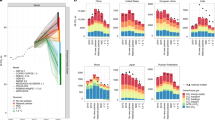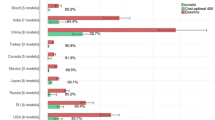Abstract
While the international community has agreed on the long-term target of limiting global warming to no more than 2 °C above pre-industrial levels, only a few concrete climate policies and measures to reduce greenhouse gas (GHG) emissions have been implemented. We use a set of three global integrated assessment models to analyze the implications of current climate policies on long-term mitigation targets. We define a weak-policy baseline scenario, which extrapolates the current policy environment by assuming that the global climate regime remains fragmented and that emission reduction efforts remain unambitious in most of the world’s regions. These scenarios clearly fall short of limiting warming to 2 °C. We investigate the cost and achievability of the stabilization of atmospheric GHG concentrations at 450 ppm CO2e by 2100, if countries follow the weak policy pathway until 2020 or 2030 before pursuing the long-term mitigation target with global cooperative action. We find that after a deferral of ambitious action the 450 ppm CO2e is only achievable with a radical up-scaling of efforts after target adoption. This has severe effects on transformation pathways and exacerbates the challenges of climate stabilization, in particular for a delay of cooperative action until 2030. Specifically, reaching the target with weak near-term action implies (a) faster and more aggressive transformations of energy systems in the medium term, (b) more stranded investments in fossil-based capacities, (c) higher long-term mitigation costs and carbon prices and (d) stronger transitional economic impacts, rendering the political feasibility of such pathways questionable.






Similar content being viewed by others
Explore related subjects
Discover the latest articles and news from researchers in related subjects, suggested using machine learning.Notes
This scenario is identical to BAU DEF presented in the RoSE synthesis paper (Kriegler et al., Submitted for publication in this special issue).
This scenario is identical to 450 DEF presented in the RoSE synthesis paper (Kriegler et al., Submitted for publication in this special issue).
While the climate modules of all three models are calibrated to a climate sensitivity of 3 °C for a doubling of CO2 concentrations relative to pre-industrial levels, they differ in terms of other characteristics, such as the carbon cycle response, or transient climate response.
Although reference GDP, population, and fossil fuel availability have been harmonized across models, baseline emissions still differ across models, reflecting different structural and technology assumptions.
The cumulative budgets for the weak actions scenarios are slightly higher than in the immediate action scenario. Due to carbon cycle dynamics, a smaller share of emissions that occur early in the century remain airborne, compared to emissions that occur at a later point in time.
In GCAM, BECCS and Gas CCS deployment in the weak action cases is lower than in the immediate action cases after 2080. For both technologies, the cost of electricity generation is higher in the WEAK action cases after 2080, due to higher bioenergy prices in the case of BECCS and the higher carbon prices applied to residual emissions in the case of Gas CCS.
The mechanism of R&D in energy efficiency is not represented in REMIND and GCAM.
It is important to note that we quantify the costs of reducing emissions, but do not consider the benefits of avoided climate damages.
In REMIND and WITCH, mitigation costs are calculated as consumption losses relative to the baseline. In GCAM, mitigation costs were calculated as the area under the marginal abatement cost curve (Calvin et al. 2009b). A discount rate of 5 % was used for the intertemporal aggregation of mitigation costs.
References
Bauer N, Mouratiadou I et al. (2013) Global fossil energy markets and climate change mitigation – an analysis with ReMIND. Clim Change. doi:10.1007/s10584-013-0901-6
Bosetti V, Carraro C, Galeotti M, Massetti E, Tavoni M (2006) WITCH - A world induced technical change hybrid model. The Energy Journal, Special Issue Hybrid Modeling of Energy-Environment Policies: Reconciling Bottom-up and Top-down:13–38
Calvin K, Edmonds J, Bond-Lamberty B, Clarke L, Kim SH, Kyle P, Smith SJ, Thomson A, Wise M (2009a) 2.6: Limiting climate change to 450 ppm CO2 equivalent in the 21st century. Energy Econ 31(Supplement 2):S107–S120. doi:10.1016/j.eneco.2009.06.006
Calvin K, Patel P, Fawcett A, Clarke L, Fisher-Vanden K, Edmonds J, Kim SH, Sands R, Wise M (2009b) The distribution and magnitude of emissions mitigation costs in climate stabilization under less than perfect international cooperation: SGM results. Energy Econ 31(Supplement 2):S187–S197. doi:10.1016/j.eneco.2009.06.014
Clarke L, Edmonds J, Krey V, Richels R, Rose S, Tavoni M (2009) International climate policy architectures: overview of the EMF 22 International scenarios. Energy Econ 31(Supplement 2):S64–S81. doi:10.1016/j.eneco.2009.10.013
De Cian E, Sferra F, Tavoni M (2013) The influence of economic growth, population, and fossil fuel scarcity on energy investments. Clim Chang. doi:10.1007/s10584-013-0902-5
Jakob M, Luderer G, Steckel J, Tavoni M, Monjon S (2012) Time to act now? Assessing the costs of delaying climate measures and benefits of early action. Clim Chang 114:79–99. doi:10.1007/s10584-011-0128-3
Kriegler E, Mouratiadou I et al (submitted for this issue) Will economic growth and fossil fuel scarcity help or hinder climate stabilization? Overview of the RoSE multi-model study. Clim Chang
Kriegler E, Petermann N et al (2013) Diagnosing integrated assessment models of climate policy. Technol Forecas Soc Change submitted
Leimbach M, Bauer N, Baumstark L, Edenhofer O (2010) Mitigation costs in a globalized world: climate policy analysis with REMIND-R. Environ Model Assess 15:155–173. doi:10.1007/s10666-009-9204-8
Luderer G, Bosetti V, Jakob M, Leimbach M, Steckel J, Waisman H, Edenhofer O (2012a) The economics of decarbonizing the energy system—results and insights from the RECIPE model intercomparison. Clim Chang 114:9–37. doi:10.1007/s10584-011-0105-x
Luderer G, DeCian E, Hourcade J-C, Leimbach M, Waisman H, Edenhofer O (2012b) On the regional distribution of mitigation costs in a global cap-and-trade regime. Clim Chang 114:59–78. doi:10.1007/s10584-012-0408-6
Luderer G, Pietzcker RC, Kriegler E, Haller M, Bauer N (2012c) Asia’s role in mitigating climate change: a technology and sector specific analysis with ReMIND-R. Energy Econ. doi:10.1016/j.eneco.2012.07.022
Meinshausen M, Meinshausen N, Hare W, Raper SCB, Frieler K, Knutti R, Frame DJ, Allen MR (2009) Greenhouse-gas emission targets for limiting global warming to 2°C. Nature 458:1158–1162. doi:10.1038/nature08017
Meinshausen M, Wigley TML, Raper SCB (2011) Emulating atmosphere–ocean and carbon cycle models with a simpler model, MAGICC6 – part 2: applications. Atmos Chem Phys 11:1457–1471. doi:10.5194/acp-11-1457-2011
Rogelj J, Nabel J, Chen C, Hare W, Markmann K, Meinshausen M, Schaeffer M, Macey K, Hohne N (2010) Copenhagen accord pledges are paltry. Nature 464:1126–1128. doi:10.1038/4641126a
Rogelj J, Hare W, Lowe J, van Vuuren DP, Riahi K, Matthews B, Hanaoka T, Jiang K, Meinshausen M (2011) Emission pathways consistent with a 2 °C global temperature limit. Nat Clim Chang 1:413–418. doi:10.1038/nclimate1258
UNEP (2010) The Emissions Gap Report - Are the Copenhagen Accord Pledges Sufficient to Limit Global Warming to 2°C or 1.5°C? United Nations Environment Programme, Nairobi, http://www.unep.org/publications/ebooks/emissionsgapreport/
UNEP (2011) Bridging the emissions gap report. United Nations Environment Programme, Nairobi, http://www.unep.org/publications/ebooks/bridgingemissionsgap/
Van Vliet J, van den Berg M, Schaeffer M, van Vuuren D, den Elzen M, Hof A, Mendoza Beltran A, Meinshausen M (2012) Copenhagen accord pledges imply higher costs for staying below 2°C warming. Clim Chang 113:551–561. doi:10.1007/s10584-012-0458-9
Wise M, Calvin K, Thomson A, Clarke L, Bond-Lamberty B, Sands R, Smith SJ, Janetos A, Edmonds J (2009) Implications of limiting CO2 concentrations for land use and energy. Science 324:1183–1186
Acknowledgments
This work was supported by Stiftung Mercator in the context of the RoSE project.
Author information
Authors and Affiliations
Corresponding author
Additional information
This article is part of a Special Issue on “The Impact of Economic Growth and Fossil Fuel Availability on Climate Protection” with Guest Editors Elmar Kriegler, Ottmar Edenhofer, Ioanna Mouratiadou, Gunnar Luderer, and Jae Edmonds.
Electronic supplementary material
Below is the link to the electronic supplementary material.
ESM 1
(DOCX 1.73 mb)
Rights and permissions
About this article
Cite this article
Luderer, G., Bertram, C., Calvin, K. et al. Implications of weak near-term climate policies on long-term mitigation pathways. Climatic Change 136, 127–140 (2016). https://doi.org/10.1007/s10584-013-0899-9
Received:
Accepted:
Published:
Issue Date:
DOI: https://doi.org/10.1007/s10584-013-0899-9




